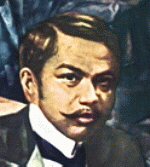
Juan Luna
(1857-1899)
A genius of the brush and a patriot of the highest order. Creator
of the world-famous painting, SPOLARIUM, which was awarded the gold
medal in the Exposicion Nacional de Bellas Artes in Madrid in 1884.
It is also known as the greatest painting of all times.
Juan Luna y Novicio was born on October 23, 1857 in Badoc, Ilocos
Norte, Philippines, the third child of seven children. He showed
took up painting and traveled to Rome to study the masters. He settled
in Paris and married Maria de la Paz, a prominent Filipina from
the Mestizaje family of Pardo de Tavera. In a rage over his suspicion
of infidelity on the part of his wife, he mercilessly shot her and
her mother to death in September 1892. Tried by a French court
and subsequently convicted in 1893, he was sentenced to pay the
victims' immediate kin but one franc each for their loss, as the
court had deemed the murders a crime of passion. In 1894, Luna
returned to the Philippines after an absence of almost 20 years.
His most famous piece, The Spoliarium, for which he won top
prize at the 1884 Madrid Exposition, is currently in the National
Museum in Manila.
Upon his return to the Philippines, he was arrested two years
later under suspicion of sedition. He was later pardoned. His
brother, General Antonio Luna, was an active participant in the insurgent Katipunan movement.
In 1898, after the United States defeated Spain in the Spanish-American
War, the fledgling Philippine Republic appointed him as a delegate
to the Paris convention and to Washington, D.C. to help gain
recognition of Philippine sovereignty and independence.
Luna died in Hong Kong, December 7, 1899. He was rushing home
from Europe after hearing of his brother’s assassination by
members of the Katipunan.
Juan Luna,Philippine National Heroes
No comments:
Post a Comment